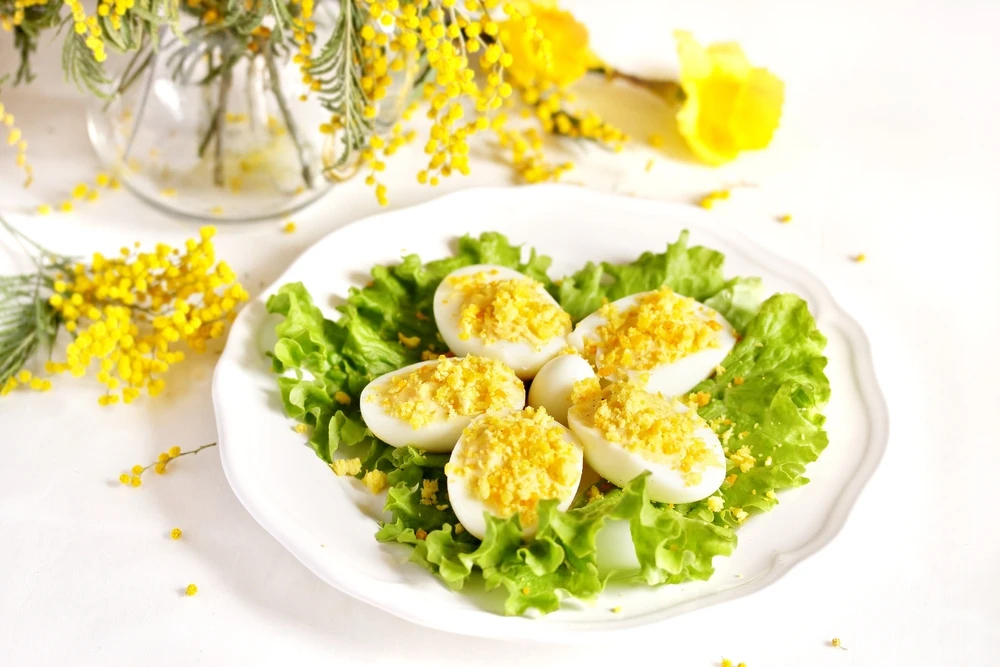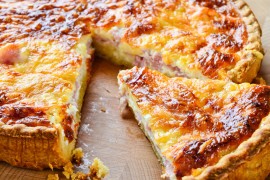The recipe for deviled eggs
The ingredients
Serves 6 people
- 11 eggs
- 60 Cl sunflower oil
- Chopped thyme (or parsley)
- 1 tablespoon of mustard
- Du sel
- Pepper
The process
- Cook 10 eggs in boiling water (Reminder: 10 minutes).
- You drain them;
- Immediately plunge them into cold water to stop the cooking process.
- With the 11th egg, you make a mayonnaise, keeping the yolk only, to which you first add mustard, then salt and pepper, and then slowly add oil, which you beat with the eggs;
- Put the mayonnaise in the fridge.
- Remove the shells from 10 boiled eggs;
- You cut them in half.
- You remove the yolks;
- Mash the yolks in a bowl.
- Add the mayonnaise to the crushed yolks.
- You mix the mixture well;
- Pour the mixture into the hollows of the hard-boiled eggs.
- Just before serving, sprinkle your mimosa eggs with chopped thyme or parsley.
ASTUCE: the top is not to make them too early before serving so that the yellow doesn't burn a little and they stay yellow well clear and well fresh. You can replace the mayonnaise with a mixture of fromage frais and yoghurt for a lighter version.
What to serve deviled eggs with?
Traditionally, mimosa eggs are served as a cold starter, accompanied by a green salad or crudités. They can also be presented as part of a apéritif dînatoire with other appetizers. Fresh and light, they go well with a glass of dry white wine, such as Sauvignon or Muscadet.
Alcohol abuse is dangerous for your health. Drink in moderation.
Putting a topping in hard-boiled eggs is as old as time.
We don't know exactly how mimosa eggs came into being, but we do know that the idea of filling the inside of an egg with something was invented very early on. Apicius, a famous Roman gourmet, used to fill them with cheese, marjoram, saffron and cloves, and bake them in the oven. In the Middle Ages we liked to fill eggs with saffron or cinnamon from the Spanish side. In France we put pig in it in 1662 and, in the 19th century, it was very chic to serve eggs hot and stuffed to your guests. And, quite honestly, it still has its little effect when you serve this dish at the table at home...
Deviled eggs: a French invention
Deviled eggs par Lyudmila Mikhailovskaya/Shutterstock.com
Having said that, forgive me for being proud, but it seems that France is once again to thank for this recipe, which is delicious and simple, but requires a bit of concentration. There's a recipe for it in "la mode" magazine in 1928, and it's done in poetry, which doesn't lack salt (by the way, you need a bit of salt in the preparation, but anyway...). ...). You'll notice that the author, whose name has been lost makes culinary rhymes!
"You are working on a mayonnaise :
You'll fill the heart of each hard-boiled egg.
So, to imitate the well walled mimosa
Pass the yolk through a sieve.
And you sprinkle the mayonnaise with it;
A little white around the edges won't hurt.
Where one will believe to see gold, in balls, pollen
Then to give the dish a festive air
Decorate your egg halves with a pink shrimp;
What the author doesn't say, as he gives the traditional recipe, is that you can incorporate a lot of things into the eggs. For example tuna, anchovies or crayfish (as in Burgundy) or even the overcome of langoustines or a slice of lobster. Super elegant!
Image by jacqueline macou de Pixabay
FAQ
Ingredients for easy Deviled eggs ?
The basic ingredients are: hard-boiled eggs, mayonnaise (or yoghurt), salt, pepper, and possibly mustard or herbs to spice things up.
How to prepare the Deviled eggs in this recipe?
Cook the hard-boiled eggs (~10 min), shell them, separate the yolks, mash them with mayonnaise/yogurt, top with the whites and refrigerate.
How long should Deviled eggs be left to stand before eating?
It's best to let them stand in a cool place for at least 30 minutes to allow the flavors to blend well.
Is it possible to vary the filling onDeviled eggs?
Yes, you can add tuna, capers, herbs (chives, parsley), or replace the mayonnaise with Greek yogurt.
Do Deviled eggs keep?
Yes, they keep for 1-2 days in the fridge, but are best prepared the same day.







